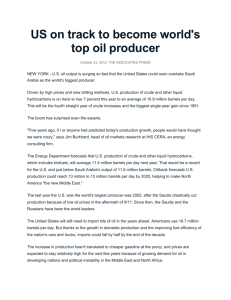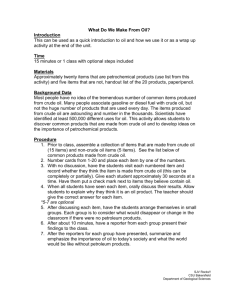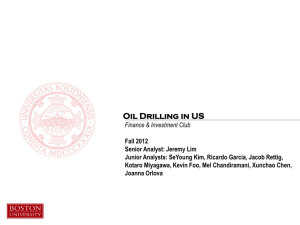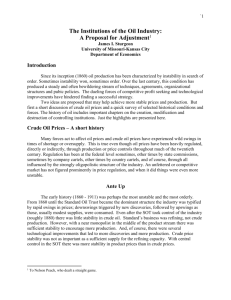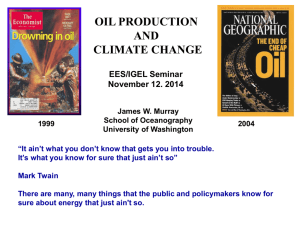November - SL
advertisement
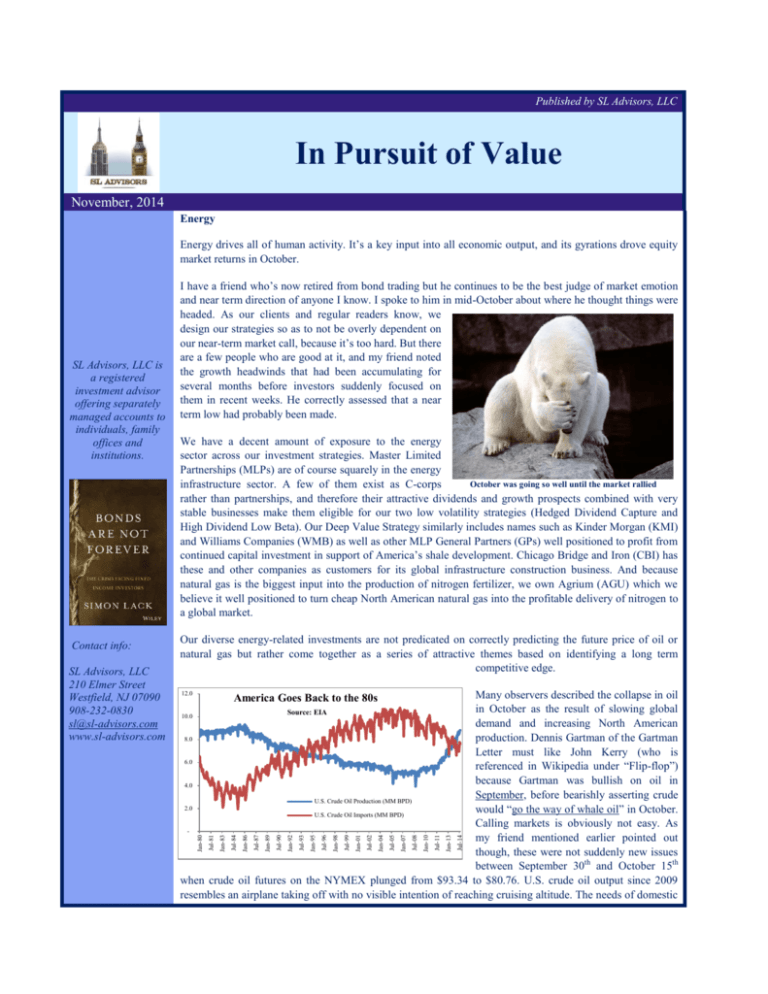
Published by SL Advisors, LLC In Pursuit of Value November, 2014 Energy Energy drives all of human activity. It’s a key input into all economic output, and its gyrations drove equity market returns in October. Many observers described the collapse in oil in October as the result of slowing global 10.0 demand and increasing North American production. Dennis Gartman of the Gartman 8.0 Letter must like John Kerry (who is 6.0 referenced in Wikipedia under “Flip-flop”) because Gartman was bullish on oil in 4.0 September, before bearishly asserting crude U.S. Crude Oil Production (MM BPD) 2.0 would “go the way of whale oil” in October. U.S. Crude Oil Imports (MM BPD) Calling markets is obviously not easy. As my friend mentioned earlier pointed out though, these were not suddenly new issues between September 30th and October 15th when crude oil futures on the NYMEX plunged from $93.34 to $80.76. U.S. crude oil output since 2009 resembles an airplane taking off with no visible intention of reaching cruising altitude. The needs of domestic 12.0 America Goes Back to the 80s Jul-14 Jul-11 Jan-13 Jul-08 Jan-10 Jul-05 Jan-07 Jul-02 Jan-04 Jul-99 Jan-01 Jul-96 Jan-98 Jul-93 Jan-95 Jul-90 Jan-92 Jul-87 Jan-89 Jul-84 Jan-86 Source: EIA Jul-81 SL Advisors, LLC 210 Elmer Street Westfield, NJ 07090 908-232-0830 sl@sl-advisors.com www.sl-advisors.com Our diverse energy-related investments are not predicated on correctly predicting the future price of oil or natural gas but rather come together as a series of attractive themes based on identifying a long term competitive edge. Jan-83 Contact info: We have a decent amount of exposure to the energy sector across our investment strategies. Master Limited Partnerships (MLPs) are of course squarely in the energy October was going so well until the market rallied infrastructure sector. A few of them exist as C-corps rather than partnerships, and therefore their attractive dividends and growth prospects combined with very stable businesses make them eligible for our two low volatility strategies (Hedged Dividend Capture and High Dividend Low Beta). Our Deep Value Strategy similarly includes names such as Kinder Morgan (KMI) and Williams Companies (WMB) as well as other MLP General Partners (GPs) well positioned to profit from continued capital investment in support of America’s shale development. Chicago Bridge and Iron (CBI) has these and other companies as customers for its global infrastructure construction business. And because natural gas is the biggest input into the production of nitrogen fertilizer, we own Agrium (AGU) which we believe it well positioned to turn cheap North American natural gas into the profitable delivery of nitrogen to a global market. Jan-80 SL Advisors, LLC is a registered investment advisor offering separately managed accounts to individuals, family offices and institutions. I have a friend who’s now retired from bond trading but he continues to be the best judge of market emotion and near term direction of anyone I know. I spoke to him in mid-October about where he thought things were headed. As our clients and regular readers know, we design our strategies so as to not be overly dependent on our near-term market call, because it’s too hard. But there are a few people who are good at it, and my friend noted the growth headwinds that had been accumulating for several months before investors suddenly focused on them in recent weeks. He correctly assessed that a near term low had probably been made. refiners for different grades of oil than are produced domestically will ensure continued imports, but clearly the happy crossing of the production/import lines didn’t come as a complete shock. The surprise was the Saudi’s lowering their prices in early October rather than leaning against the prevailing trend, generating all kinds of conspiracy theories about influencing the behavior of other OPEC members whose domestic expenditure relies on far higher prices. What seemed clear to us was that a lower oil price helps more than it hurts. The Economist noted that the approximately $30 drop in crude oil that’s taken place since June, if maintained for a year, would represent a shift of $1 trillion from producers to consumers. Because consumers are more likely to spend their windfall than producers, it’s worth about 0.5% to global GDP. Unless you’re an oil E&P company or a provider of infrastructure to the marginal producer, this is a good thing. This second point is something we care about, since the growth prospects of many MLPs including those we own is predicated on the continued development of domestic oil and gas production. Horizontal drilling in shale formations is characterized by wells with much faster decline rates than with conventional drilling. The high pressure created by “fracking” initially delivers great volumes that quickly decline even while ultimate recovery can extend for many years. The relatively high early production delivers a similarly fast return on the capital expenditure incurred in drilling the well. This allows shale drillers to be somewhat more responsive to near term prices in their production decisions. The continued increase in U.S. production demonstrates that the technology keeps improving, further reducing operating costs. SL Advisors, LLC focuses on identifying securities that are trading at a discount to intrinsic value. Some reports have the Saudis looking to force marginal U.S. producers out of business by maintaining current prices. However, domestic operators offer a different perspective. Enterprise Products (EPD) CEO Michael Creel recently said that most if not all drillers in the key oil plays such as Eagle Ford, Permian and Bakken are profitable at prices below today’s, and didn’t see much danger of U.S drilling grinding to a halt. NuStar’s (NS) recent investor call reported that producers were not cutting back, not least because short term output was already contracted and unaffected. Domestic costs of production continue to fall. For example, Range Resources (RRC) is an E&P name we’ve long followed that is primarily in the Marcellus shale in SW Pennsylvania. As shown in the chart, their production cost for gas per MCFE (thousand cubic feet equivalent) has declined 39% since 2008. Economies of scale as well as improved knowledge and technology have driven this result. Moreover, this has happened in spite of Transportation and Gathering costs rising from $0.08 per MCFE to $0.77. Incidentally, Markwest Energy Partners (MWE), one of our MLP holdings, is one of the beneficiaries of this increased line item. Vaclav Smil is a prolific author of books that explain how science interacts with commerce in today’s society. He is apparently Bill Gates’ favorite writer. Smil digs into the most fundamental details of how the modern world works backed up by startling data. For example, in his book simply titled Energy, the chapter on the biosphere and use of hydropower informs that the planetary water cycle (i.e. precipitation to evaporation) moves almost 580,000 km3 annually, which equates to an average annual rainfall of 1.1 metres (I think London and Seattle get more than their fair share). He notes that the modern extraction of crude oil was stimulated by the desire for a cheaper alternative to whale oil, whose subsequent demise Dennis Gartman apparently believes crude oil will shortly follow. All of which hopefully shows that researching the energy sector never ceases to be interesting.





